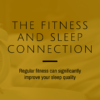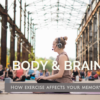Did you know cycling scientifically improves your mental health?

If you didn't know, now you know: one our cycling instructors, Marissa Venvanzi is working on her Masters in Physician Assistant Science! She's been studying the positive affects cardiorespiratory fitness (i.e. cycling) has on our mental health and wanted to share her findings with the Triangle Foundry family! Check it out:
The best part about being a health science student and fitness enthusiast is the overlap that exists between the two passions.The worst part is the effort that a Capstone project requires. I had a bit of a Hannah Montana moment during the first semester of my senior year of undergrad trying to find the “best of both worlds,” fitness and biology, in order to create a research project that would not only allow me to graduate but also make the early mornings and late nights of lab work enjoyable.
The perfect opportunity presented itself when I was accepted into a research group focusing on finding correlations between mental and physical health.As a whole, this research explores the factors of heart rate variability, blood hormone levels, sleep, PARQ+ testing (the typical mental health check done in clinics), body measurements, BMI, cardiorespiratory fitness, and athletic scoring.More specifically, I am the researcher responsible for researching the aspect of cardiorespiratory fitness… How perfect for a spin instructor?!
Cardiorespiratory fitness is basically how well the heart and lungs work together to provide an oxygen-rich blood supply to skeletal muscles during physical activity.We test this aspect of physical fitness by conducting a VO2max Test, which is considered the best standard by which to measure CRF.In this testing, the subject walks at 3.0 speed on a treadmill with an incline that increases in even increments and is asked their perceived exertion at each increase, as well as getting their heart rate and blood pressure monitored.When the subject is at their perceived maximal exertion, maximum heart rate, or has walked for 25 minutes if they’re superhuman, they are then taken through a cool-down routine while the researcher does a bunch of math with the heart rate and BP measurements to determine the individual’s VO2max.
Now, what does any of this mean for people who are not trying desperately to finish their Capstone research?As stated previously, cardiorespiratory fitness encompasses the ability of the lungs to uptake oxygen and the heart/circulatory system’s ability to pump the oxygenated blood to exerted muscles.High CRF values indicate that the heart, lungs, and skeletal system are working healthily and harmoniously.High CRF has been associated with decreased risk of mortality from cardiovascular disease and is also supported to regulate heart rate and blood pressure (Kodama et al., 2009).High CRF has also been supported to correlate positively with high positive affect scores, meaning that individuals with higher cardiorespiratory fitness are supported to have more positive interactions with their environment (Manuel et al., 2020).Similarly, high CRF is associated with lower autonomous nervous system stress reactivity in adults and adolescents, meaning that the reflexive fight-or-flight stress response is decreased for non-dire situations (Manuel et al., 2020).My research is not complete, however there are countless scholarly studies exploring this concept and the mental and physical health benefits that it is associated with.A search of “cardiorespiratory fitness” in Google Scholar provides vast information, although I will admit the reading is very bland at times.
For those who are looking to increase their cardiorespiratory fitness to cash out on some serious mental and physical benefits, aerobic exercise is your best friend!I have only conducted research on a little over a handful of subjects thus far so no significant conclusions can be made as of yet, however it appears that those who partake in more physical activity have higher CRF values.Ross et al., 2020 supports that most individuals can increase their CRF by increasing the intensity of their workouts or increasing the amount of which they exercise.For those who want to increase intensity, spin is an amazing workout to consider for heart, lung, muscle, joint, and mental health, as well as building a community with the other exercise enthusiasts sweating their butts off with you!Just think, it's much better than doing the VO2max treadmill test in a creepy biology lab at 7am on a Saturday!
Citations
Kodama S, Saito K, Tanaka S, Maki M, Yachi Y, Asumi M, et al. Cardiorespiratory fitness as a quantitative predictor of all-cause mortality and cardiovascular events in healthy men and women: a meta-analysis. JAMA - J Am Med Assoc. 2009;301: 2024–2035. doi:10.1001/jama.2009.681
Manuel, M., Ludyga, S., Brande, S., Colledge, F., Puhse, U., & Gerber, M. (2021). APA PsycNet. Retrieved January 3, 2021, from Apa.org website: https://psycnet.apa.org/record/2020-07397-001
Ross, R., de Lannoy, L., & Stotz, P. J. (2015). Separate Effects of Intensity and Amount of Exercise on Interindividual Cardiorespiratory Fitness Response. Mayo Clinic Proceedings, 90(11), 1506–1514. https://doi.org/10.1016/j.mayocp.2015.07.024






